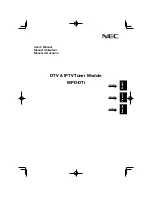
MFJ-969 DELUXE Versa Tuner II
4
Using The MFJ-969
CAUTION: Never change the ANTENNA selector switch position while
transmitting! Never apply more than 300 Watts to the MFJ-969!
In any conventional "T" network tuner, maximum power handling and the smoothest
tuning occurs when the capacitance in the network is as large as possible. In this tuner the
TRANSMITTER and ANTENNA controls have maximum capacitance at position 0 (fully
meshed), and minimum capacitance at position 10 (fully open). Be sure to use the highest
possible capacitance for each band. This will provide the smoothest tuning, highest
efficiency, and greatest power handling capability. The chart in the tuning instructions
shows typical capacitor settings that can be used for each amateur band.
The ROLLER INDUCTOR in the MFJ-969 has maximum inductance in the full counter-
clockwise position (at the highest number, around 117), and minimum inductance in the
full clockwise rotation (at the lowest number, 000). The counter is reset by turning the
inductor knob to the full counter clockwise position, and pushing a small pointed object
into the hole to the right of the turns counter. This will reset the counter to zero.
Less inductance is required as frequency is increased. If too little inductance is used, the
tuner may not match the load properly. If too much inductance is used, the tuner will be
"touchy" and power handling will be compromised. The chart in the tuning instructions
shows typical ROLLER INDUCTOR settings for each amateur band.
NOTE:
If your transmitter uses an adjustable output circuit it must be properly tuned into
a 50 ohm load at the operating frequency. Proper tuning can be accomplished by
placing the ANTENNA SELECTOR switch in the fully clockwise
BYPASS
DUMMY LOAD position. Adjust the transmitter according to the manufacturer's
instructions into the 50 ohm dummy load
before
adjusting the tuner.
NOTE:
The MFJ Air Core Roller Inductor is designed with an exclusive Self-Resonance
Killer that keeps potentially damaging self-resonances away from your operating
frequency. This feature is switched in and out of the circuit wiht a built-in switch
in the roller. Therefore as you turn the roller up and down, you may feel a bump.
This is normal and you should not be alarmed.
Most modern solid state transceivers do not require adjustments. If the transceiver has a
built in antenna tuner, be sure it is turned off or disabled.
After properly preparing the transmitter, place the MFJ-969 ANTENNA SELECTOR
switch in the desired antenna position in the BYPASS area. If the SWR is low (very little
or no reflected power), the tuner can be left in this position.
If the SWR is higher than desired, place the ANTENNA SELECTOR switch in the proper
TUNED area that selects the desired antenna. Adjust the tuner as described below to
obtain the best SWR. Do NOT change the transmitter's tuning (plate) or loading (antenna)
controls until after the tuner has been fully adjusted. The transmitter can be "touched up"
(if necessary)
after
the MFJ-969 is fully tuned.




























